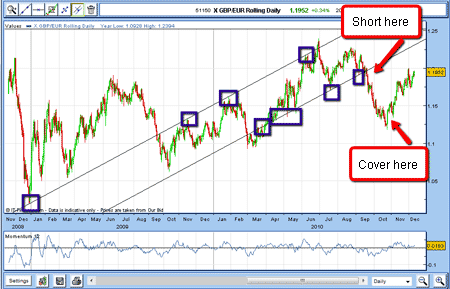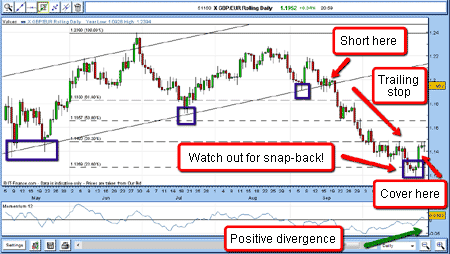Sterling v the euro: a great trading vehicle for spread-betting
This GBP/EUR trade illustrates how an observant trader can win against the big boys, simply by using basic technical analysis tools and reading market sentiment.
One of the few non-dollar currency crosses I like to trade is the GBP/EUR (sterling versus the euro). It is has a very large following, and it behaves itself as well as any currency cross with regard to the technical analysis methods I use. Spreads offered by most spread-betting firms are usually very tight, which means it is cheap to trade.
Because the eurozone is the UK's biggest trading partner (taking about one half of our exports), the cross rate is of great interest to commercial firms of all kinds. The profits of such firms are heavily dependent on this rate, and there is much hedging of currency risk to attempt to protect profits. Getting the forecast wrong can be very expensive.
To see why, you just need to look at the price chart. For example, since March, the rate has swung from €1.09 to €1.24 in June a move of 14% in three months. Hedging at the wrong time could well wipe out profit margins and then some! Of course, many sophisticated hedging strategies have been developed using swaps and options as well as futures. But currency exchange risk cannot entirely be eliminated. The large trading banks have whole trading floors devoted to managing currency risk for themselves and their clients.
MoneyWeek
Subscribe to MoneyWeek today and get your first six magazine issues absolutely FREE

Sign up to Money Morning
Don't miss the latest investment and personal finances news, market analysis, plus money-saving tips with our free twice-daily newsletter
Don't miss the latest investment and personal finances news, market analysis, plus money-saving tips with our free twice-daily newsletter
Of course, us spread-betting traders have the luxury of choosing if and when we trade, unlike commercial firms. In fact, when we trade, we are often trading against the banks, so we need to be better than them at forecasting! No pressure, then.
A very profitable trade in the GBP/EUR
Since I am 'swing trading' trying to catch the intermediate term moves my entry points must be almost pip-perfect. When looking to short, I will be selling at the tips of rallies. When looking to go long, I am looking to buy at the tips of dips. That means using resting entry orders that sit in the market until the market passes through my price, at which time the order is filled. I must then move swiftly to enter my protective stop, which I have worked out beforehand using my 3% rule.
What are the factors that move the GBP/EUR market? The macro factors, such as trade flows, interest rates, inflation rates, (and now sovereign debt!), as well as private debt, all go into the equation. But it is the market participants' sentiment of the prevailing rate that moves the market from one pip to the next.
As I write, sentiment is growing more positive towards GBP than the euro. This is because traders believe the UK government can implement its spending cuts and bring the huge budget deficit down. Meanwhile, worries over other problem euro economies (Portugal, especially) have not gone away.
But as we know, markets can overdo things, and after the 14% rally, I was looking for a top in October, leading to a significant correction (my 'swing'). When the market made a dip on 6 September and rallied again, I was able to draw a nice pair of tramlines connecting many points, as you can see on the chart below.

On 8 September, the market bounced off the lower tramline (see the final purple box on the chart above), then rallied to the €1.22 level but then headed lower back to the tramline. I then placed my entry 'sell' order just below the tramline at €1.1950 (indicated above). If my tramline theory was wrong, a move to the €1.2050 level would prove it to me. So that is where I placed my protective stop. My sell order was filled a day later.
14 Sept sold £1 rolling GBP/EUR @ 1.1950.
Stop @ 1.2050.
Risk £100 (2% of account)
The market hovered around the tramline for a few days, but then made a decisive move down on 20 September. When it broke beneath the €1.17 level (chart support) on 22 September, I knew we had a good move on my hands. But to protect my position, I lowered my stop to break-even, following my break-even rule.
Because the market was moving down rapidly in October, I decided to employ my trailing stop strategy. This entails moving my stop to a point just above the previous day's high day-by-day. Momentum was getting oversold, and the market could snap back quickly at any time (as you can see on the chart below), and I wanted to capture as much of the move as possible.

Also, there was a potential positive divergence with momentum forming and the market was approaching the Fibonacci 76.4% retrace of the last major wave from the March low of €1.09 to the June high at €1.24. Time to be vigilant.
I was finally taken out on 26 October, for a good gain, on the snap-back rally I had been expecting.
26 Oct covered rolling GBP/EUR @ 1.1350.
Profit £600 on £1 bet and £100 risk.
Why watching sentiment is critical for traders
This was a sizable correction to the March June bull run, and indicated how bullish the market was at the top. The story of improving sentiment on the UK budget deficit, combined with deteriorating eurozone "fundamentals" was bought hook, line, and sinker by the market.
That is what makes tops.
This trade illustrates how an observant trader can win against the big boys, simply by using basic technical analysis tools, and taking a reading of market sentiment. Such sentiment readings are not 'scientific', as raw data are not available for this cross. But a regular reading of mainstream financial reports is a good proxy.
In 2010, we are seeing some of the greatest extremes ever recorded in sentiment in several markets, but especially in stocks and precious metals.
As a result, swings have been very large, and we have been trading in happy hunting grounds. And luckily, it's a situation I expect to continue in 2011.
Get the latest financial news, insights and expert analysis from our award-winning MoneyWeek team, to help you understand what really matters when it comes to your finances.
John is is a British-born lapsed PhD physicist, who previously worked for Nasa on the Mars exploration team. He is a former commodity trading advisor with the US Commodities Futures Trading Commission, and worked in a boutique futures house in California in the 1980s.
He was a partner in one of the first futures newsletter advisory services, based in Washington DC, specialising in pork bellies and currencies. John is primarily a chart-reading trader, having cut his trading teeth in the days before PCs.
As well as his work in the financial world, he has launched, run and sold several 'real' businesses producing 'real' products.
-
 How gifting money this Christmas could lower your inheritance tax bill
How gifting money this Christmas could lower your inheritance tax billCash is an easy and quick present to give over Christmas – and it could protect some of your estate from the taxman down the line
-
 £100 contactless card limit to be lifted
£100 contactless card limit to be liftedConsumers will be able to set their own contactless limits from March 2026, under new rules from the Financial Conduct Authority